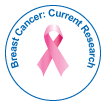The Challenge of pN3 Stage in Breast Cancer
Received: 01-Aug-2016 / Accepted Date: 05-Aug-2016 / Published Date: 15-Aug-2016 DOI: 10.4172/2572-4118.1000e103
327PN3 Stage
Since 1959 the American Joint Committee on Cancer (AJCC) TNM system has been used to stage breast cancer. Since then, the TNM has helped clinicians in deciding the better treatment for each patient [1]. Periodically revisions have been made to this classification with the aim of keeping a relationship between the disease extent and the prognosis. However, when we talk about breast cancer, the TNM is not always enough.
Several publications in the last years report that there are other predictive factors that influence the prognosis, measured by the overall survival or the DFS (disease-free survival), as much as the TNM stage does. Some authors claim that important factors as primary tumor histologic grade and biologic tumor markers should be included in the AJCC system [1]. Every clinician who take part in the breast tumor committee in their respective hospital knows that these authors have good reasons to make this claim. Factors as the histologic grade (G1, G2, G3 determined by Elston or Scarff grading system) and the biomarkers testing (ER, PR, Her 2) gives us lots of information about the prognosis of the patient as well as the therapeutic attitude that we have to choose.
Especially difficult for professionals is the case of the pN3 stage. Approximately 8% to 30% of newly diagnosed breast cancers are at an advanced stage, considering the pN3 the stage with the worse prognosis when we talk about patients without distant metastasis [2,3]. According to the AJCC TNM staging in this step we include patients with: Metastases in ipsilateral infraclavicular (level III axillary) lymph node(s) with or without level I, II axillary lymph node involvement (N3a); or in clinically detected ipsilateral internal mammary lymph node(s) with clinically evident level I, II axillary lymph node metastases (N3b); or metastases in ipsilateral supraclavicular lymph node(s) with or without axillary or internal mammary lymph node involvement (N3c).
5-year overall survival rate for pN3 breast cancer has classically been reported around 40% [4]. Although some recent studies with standard treatment report numbers around 60% 5 the prognosis is still not good. In addition, when authors analyze these outcomes they find out that the prognosis is very heterogeneous between patients included in this group. The question we should all ask is: Do we need anything else than the TNM to divide the pN3 patients according to their prognosis? Some studies have been carried out trying to define which these prognostic factors could be [5,6]. The age, the lymph node ratio, the serum neutrophil/lymphocyte ratio and of course the histologic grade are some factors that have been suggested to influence in the tumor recurrence and survival outcomes [6].
We face a subject with still lots of doubts and little information. The real fact is that the 5-year overall survival for this group is still poor and that we need more prospective studies which could define the unfavorable prognostic factors in these heterogeneous group of patients. Maybe when we could identify those patients with less opportunities of having a good clinical outcome, we would be able to offer them more specific treatment to improve it.
References
- Yi M, Mittendorf EA, Cormier JN, Buchholz TA, Bilimoria K, et al. (2011) Novel staging system for predicting disease-specific survival in patients with breast cancer treated with surgery as the first intervention: time to modify the current American Joint Committee on Cancer staging system. J Clin Oncol 29: 4654-4661.
- Kuru B, Camlibel M, Dinc S, Gulcelik MA, Alagol H (2003)Prognostic significance ofaxillary node and infraclavicular lymph node status after mastectomy. Eur J Surg Oncol 29: 839-844
- Montero AJ, Rouzier R, Lluch A, Theriault RL, Buzdar AU, et al. (2005) The natural history of breast carcinoma in patients with > or = 10 metastatic axillary lymph nodes before and after the advent of adjuvant therapy: a multiinstitutional retrospective study. Cancer 104: 229 -235.
- Basaran G, Devrim C, Caglar HB, Gulluoglu B, Kaya H, et al. (2011) Clinical outcome of breast cancer patients with N3a (≥10 positive lymph nodes) disease: has it changed over years? Med Oncol 28: 726-732
- Yu JI, Park W, Choi DH, Huh SJ, Nam SJ, et al. (2015) Clinical Outcomes and Prognostic Factors of Pathologic N3 Breast Cancer Treated With Modern Standard Treatments. Clin Breast Cancer 15: 512-518.
- Kim YY, Park HK, Lee KH, Kim KI, Chun YS (2016)Â Prognostically Distinctive Subgroup in Pathologic N3 Breast Cancer. J Breast Cancer 19: 163-168.
Citation: Gomez AA (2016) The Challenge of pN3 Stage in Breast Cancer.Breast Can Curr 1: e103. DOI: 10.4172/2572-4118.1000e103
Copyright: ©2016 Gomez AA. This is an open-access article distributed under the terms of the Creative Commons Attribution License, which permits unrestricted use, distribution, and reproduction in any medium, provided the original author and source are credited.
Share This Article
Recommended Journals
Open Access Journals
Article Tools
Article Usage
- Total views: 14155
- [From(publication date): 9-2016 - Apr 16, 2025]
- Breakdown by view type
- HTML page views: 13314
- PDF downloads: 841
